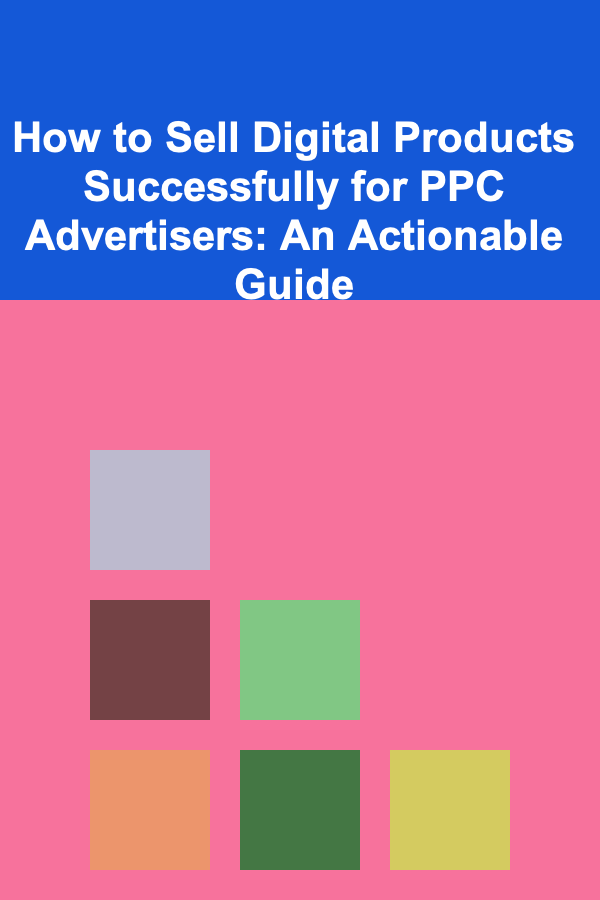
How to Sell Digital Products Successfully for PPC Advertisers: An Actionable Guide
ebook include PDF & Audio bundle (Micro Guide)
$12.99$11.99
Limited Time Offer! Order within the next:

Selling digital products through paid advertising, particularly Pay-Per-Click (PPC) campaigns, requires a well-thought-out strategy, keen insights into your audience, and optimized campaigns that maximize ROI. Whether you are selling software, eBooks, online courses, digital downloads, or any other form of digital product, the path to success is nuanced. This guide will walk you through actionable steps to ensure your PPC campaigns are successful, helping you scale your digital product business efficiently.
Understanding Your Audience and Buyer Persona
Before diving into the PPC world, understanding your target audience is crucial. Identifying the ideal buyer persona will help you craft targeted campaigns that speak to their needs and pain points. Here are some key factors to consider:
- Demographics: Age, gender, income, location, and occupation.
- Psychographics: Interests, values, behaviors, and lifestyle choices.
- Pain Points: What problems are your digital products solving for your customers?
- Buying Intent: Are they just browsing, or are they ready to make a purchase?
Actionable Tip:
Conduct surveys or interviews with your existing customers or potential users. Use tools like Google Analytics or Facebook Audience Insights to gather data about your audience's behaviors and preferences. Build buyer personas to guide your advertising strategy.
Choosing the Right PPC Platforms
Not all PPC platforms are created equal. Depending on your digital product and the behavior of your target audience, different platforms will yield different results. Here's a breakdown of some popular platforms:
Google Ads
Google Ads is the most popular PPC platform. It's ideal for capturing high-intent traffic since users are often searching for solutions related to your product. Google Ads can target keywords related to your digital product and serve your ads to users searching for those terms.
- Best for: Direct product searches, informative content (like eBooks), software tools, and solutions.
- Ad Types: Search ads, display ads, video ads.
Facebook and Instagram Ads
Facebook and Instagram have massive user bases, with advanced targeting options. These platforms work well if your digital products appeal to a broad audience. Their visual nature is great for selling courses, tutorials, and eBooks, where imagery can play a huge role in conversions.
- Best for: eCommerce products, online courses, digital downloads, and visually rich content.
- Ad Types: Carousel ads, video ads, lead generation ads, and dynamic product ads.
Bing Ads
While smaller than Google, Bing Ads can be an untapped resource for PPC advertisers. It's cheaper than Google Ads and may still reach a relevant audience.
- Best for: Niche audiences, budget-conscious advertisers, and users with less competition.
Actionable Tip:
Select platforms where your target audience spends the most time. Use analytics and A/B testing to determine which platform brings the most relevant traffic and adjust your ad spend accordingly.
Effective Keyword Research
Keyword research is the foundation of PPC campaigns. To sell digital products successfully, you must target keywords with the right intent. In PPC advertising, keywords can be divided into three primary categories:
- Transactional Keywords: These are high-intent keywords used by customers who are ready to buy. For example, "buy Photoshop software" or "best digital course on marketing."
- Informational Keywords: These are keywords used by potential customers looking for information, but not necessarily to buy right away. For instance, "how to use Photoshop" or "learn digital marketing."
- Branded Keywords: These target customers already familiar with your product or brand. These keywords help capture the traffic of people who are specifically searching for your brand name or product.
Actionable Tip:
Use tools like Google Keyword Planner, Ahrefs, or SEMrush to conduct thorough keyword research. Focus on high-converting, long-tail keywords that match the intent of users likely to purchase your digital product. Also, ensure negative keywords are included to avoid irrelevant traffic.
Crafting Compelling Ad Copy
The ad copy is the first impression users get of your digital product, so it must be compelling, clear, and aligned with their needs. Your ad copy should:
- Highlight the product benefits: Clearly state how your digital product will solve a problem or provide value.
- Include a strong call-to-action (CTA): Encourage users to take immediate action, whether it's "Buy Now," "Learn More," or "Start Free Trial."
- Incorporate keywords: Make sure your ad copy aligns with the keywords you're bidding on. This improves relevance and Quality Score, reducing your cost-per-click (CPC).
- Use urgency and exclusivity: Creating a sense of urgency, such as "limited time offer," or exclusivity like "exclusive members-only content," can drive conversions.
Actionable Tip:
Use A/B testing to experiment with different ad copies and headlines. Test CTAs, the tone of voice (e.g., formal vs. casual), and benefit-oriented phrasing to see which combinations produce the highest conversion rates.
Landing Page Optimization
Your landing page plays a pivotal role in PPC success. A well-designed landing page ensures a smooth user experience and boosts conversion rates. Here are some best practices:
- Relevant and Consistent Messaging: Ensure that the message in your ad matches the content on the landing page. If the ad promises an eBook, make sure the landing page showcases that eBook with a clear value proposition.
- Mobile Optimization: A significant portion of PPC traffic comes from mobile users. Ensure that your landing page is mobile-friendly and loads quickly.
- Fast Loading Speed: Slow landing pages will increase bounce rates and decrease conversions. Use tools like Google PageSpeed Insights to test and improve your page speed.
- Clear CTA: Your landing page should have a prominent CTA, such as "Download Now," "Buy Now," or "Start Free Trial," positioned above the fold.
- Social Proof and Testimonials: Display reviews, ratings, or testimonials from satisfied customers to build trust and credibility.
Actionable Tip:
Use heatmap tools (like Hotjar or Crazy Egg) to understand how users are interacting with your landing page. Based on the data, optimize areas where users seem to drop off or fail to engage with the CTA.
Setting Up Conversion Tracking and Analytics
Tracking the success of your PPC campaigns is essential for optimizing and scaling. Without proper tracking, you'll be blind to what's working and what isn't. Here's how to set up and use conversion tracking effectively:
- Google Ads Conversion Tracking: Set up conversion tracking within Google Ads to track the specific actions users take after clicking on your ad (e.g., purchase, download, sign-up).
- Google Analytics: Integrate Google Ads with Google Analytics to get detailed insights into user behavior on your landing page. This will help you understand the customer journey and make necessary adjustments.
- Facebook Pixel: If you are running Facebook ads, install the Facebook Pixel on your website to track and retarget visitors who didn't convert on their first visit.
Actionable Tip:
Set up multi-touch attribution tracking to gain insights into the customer journey across different channels. This helps you understand the role each platform and touchpoint plays in the conversion process.
Budgeting and Bid Management
Effective budgeting and bid management ensure that you are not overspending while getting the maximum ROI. Here's how you can manage your budget effectively:
- Daily or Lifetime Budgets: Determine whether you want to set a daily budget or a lifetime budget for your PPC campaigns. A daily budget gives you more control, while a lifetime budget allows more flexibility based on campaign performance.
- Smart Bidding: Platforms like Google Ads offer smart bidding strategies like Target CPA (Cost per Acquisition) or Target ROAS (Return on Ad Spend). These automated strategies help you achieve your goals without constant manual bid adjustments.
- Campaign Segmentation: Segregate campaigns by product type, audience, or keyword to better manage and allocate your budget.
Actionable Tip:
Monitor your campaign performance regularly and pause or adjust underperforming ads. Reallocate budget to the best-performing ads and continuously optimize your bidding strategies based on performance metrics.
Retargeting and Remarketing
Not all visitors will convert immediately, which is why retargeting and remarketing are essential components of any successful PPC strategy. Retargeting allows you to target people who have interacted with your website but didn't convert. This can significantly increase your conversion rates.
Actionable Tip:
Set up retargeting ads on platforms like Google and Facebook to re-engage users who have visited your landing page or abandoned their cart. Use personalized ads and offers based on their interaction history to encourage conversion.
Continuous Testing and Optimization
The digital advertising landscape is always evolving, and PPC campaigns need continuous optimization to stay relevant. Regularly analyze your campaigns' performance, test new strategies, and optimize based on data. Here's how:
- A/B Testing: Constantly test different aspects of your ads, such as headlines, CTAs, images, and ad formats. Use the results to refine your ad strategy.
- Monitor Analytics: Keep a close eye on key performance indicators (KPIs) such as CTR (Click-Through Rate), CPC, conversion rates, and ROI.
- Optimize for Quality Score: Google Ads and other PPC platforms use Quality Score to determine ad relevance. Improve this score by ensuring that your keywords, ad copy, and landing pages align.
Actionable Tip:
Set up weekly or monthly review sessions to analyze campaign data. Make adjustments based on what's working, and continuously test and refine your campaigns for optimal results.
Conclusion
Selling digital products successfully through PPC advertising is a dynamic and ongoing process. It requires a deep understanding of your target audience, the right platform selection, keyword optimization, compelling ad copy, optimized landing pages, and rigorous testing. By following these actionable steps, PPC advertisers can build more effective campaigns, increase conversions, and drive sustainable growth for their digital product business. Keep learning, optimizing, and staying up-to-date with industry changes, and success will follow.

Affordable Options for Home Insurance That Won't Break the Bank
Read More
How to Maximize Small Office Spaces with Smart Solutions
Read More
How to Use a Filing System for Paper Management
Read More
How to Protect Your Brain from Sleep Deprivation
Read More
How to Build a Camping Checklist for Winter Camping in the Snow
Read More
10 Tips for Mentoring Graduate Students Effectively as a Professor
Read MoreOther Products

Affordable Options for Home Insurance That Won't Break the Bank
Read More
How to Maximize Small Office Spaces with Smart Solutions
Read More
How to Use a Filing System for Paper Management
Read More
How to Protect Your Brain from Sleep Deprivation
Read More
How to Build a Camping Checklist for Winter Camping in the Snow
Read More